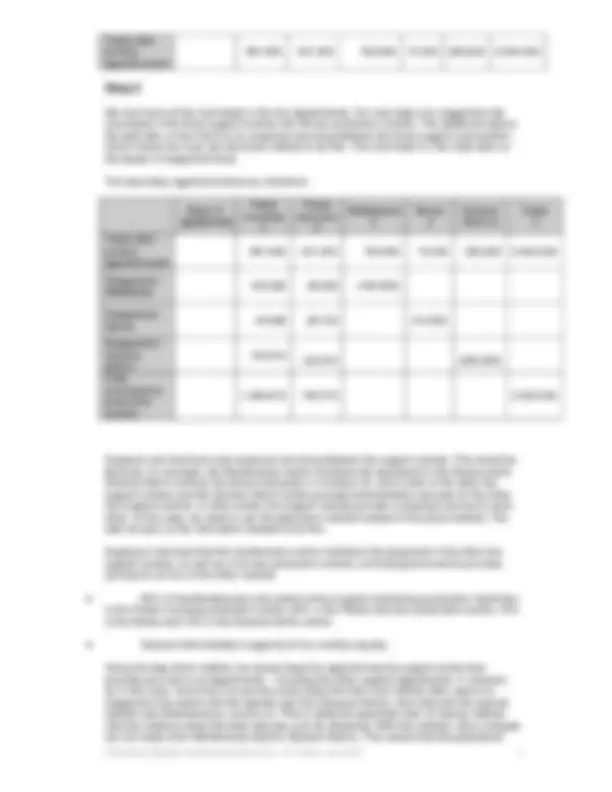




Study with the several resources on Docsity

Earn points by helping other students or get them with a premium plan


Prepare for your exams
Study with the several resources on Docsity

Earn points to download
Earn points by helping other students or get them with a premium plan
Community
Ask the community for help and clear up your study doubts
Discover the best universities in your country according to Docsity users
Free resources
Download our free guides on studying techniques, anxiety management strategies, and thesis advice from Docsity tutors
An in-depth explanation of the methods and processes involved in calculating a company's budgeted overhead absorption rates. It covers primary and secondary apportionment, using examples from the aat qualification's crs sample paper. Understanding these concepts is crucial for candidates in unit 6 (recording and evaluating costs and revenues) and the new costs and revenues unit.
What you will learn
Typology: Lecture notes
1 / 4

This page cannot be seen from the preview
Don't miss anything!



There are several possible methods for calculating a company’s budgeted overhead absorption rates. Les Nightingale takes you though them
Both the current Unit 6 (Recording and Evaluating Costs and Revenues) and the new Costs and Revenues (CRS) unit within the Revised AAT Qualification require candidates to be able to calculate budgeted overhead absorption rates.
There are three steps in this process:
Let us now look in detail at the first two steps, using task 1.4 from the CRS sample paper as an example.
Broadsword Ltd’s budgeted overheads for the next financial year are:
Depreciation of plant and equipment
Power for production machinery 715,
Rent and rates 104,
Light and heat 23,
Indirect labour costs:
Maintenance 101,
Stores 36,
General Administration 240,
Total indirect labour cost 377,
The following information is also available:
Department
Net book value of plant and equipment
Production machinery power usage (KwH)
Floor space (square metres)
Number of employees
Production centres:
Plastic moulding 5,600,000 2,145,000 14
Plastic extrusion 2,400,000 1,430,000 10
Support cost centres:
Maintenance 14,000 5
Stores 8,400 2
General administration
Total 8,000,000 3,575,000 28,000 38
Overheads are allocated or apportioned on the most appropriate basis. The total overheads of the support cost centres are then reapportioned to the two production centres using the direct method.
We simply allocate some of the overheads to the department where they are incurred. This is the case with the indirect labour costs. We then share, or apportion, the remaining overheads across the various departments on the most reasonable basis. Rent and rates, for example, are spread based on the floor area of each department.
The primary apportionments are, therefore:
Basis of apportionment
Plastic moulding £
Plastic extrusion £
Maintenance £
Stores £
General Admin £
Totals £
Depreciation of plant and equipment
NBV of plant and equipment
Power for production machinery
Production machinery power usage (KwH)
Rent and rates
Floor space 52,250^ 31,350^ 20,900 104,
Light and heat
Floor space
Indirect labour Allocated 101,150 (^) 36,050 240,100 377,
charged for Maintenance change, because the 10% of the Maintenance department’s time spent in the General Admin centre is ignored. (50/90; 30/90 and 10/90 are charged to the remaining three centres).
The revised secondary apportionments become:
Basis of apportionment
Plastic moulding £
Plastic extrusion £
Maintenance £
Stores £
General Admin £
Totals £
Totals after primary apportionment
Reapportion General Admin
Reapportion Maintenance
Reapportion Stores
Total overheads to production centres
We can see that the choice of secondary apportionment method has changed the total overheads in each of the production centres, which will in turn affect their budgeted overhead absorption rates.
The final step is to calculate the budgeted overhead absorption rates themselves. Suppose that in the step down example, above, the overheads were to be recovered on the machine hour basis, and the budgeted machine hours were 25,734 for the Plastic moulding department and 18,434 for the Plastic extrusion department.
The budgeted overhead absorption rates would be:
Plastic moulding: £1,286,706/25,734 = £50 per machine hour
Plastic extrusion: £737,344/18,434 = £40 per machine hour
Les Nightingale is Chief Assessor for Unit 6